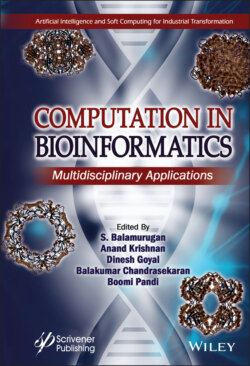Читать книгу Computation in BioInformatics - Группа авторов - Страница 2
Table of Contents
Оглавление1 Cover
2 Title Page
3 Copyright
4 Preface
5 1 Bioinfomatics as a Tool in Drug Designing 1.1 Introduction 1.2 Steps Involved in Drug Designing 1.3 Various Softwares Used in the Steps of Drug Designing 1.4 Applications 1.5 Conclusion References
6 2 New Strategies in Drug Discovery 2.1 Introduction 2.2 Road Toward Advancement 2.3 Methodology 2.4 Role of OMICS Technology 2.5 High-Throughput Screening and Its Tools 2.6 Chemoinformatic 2.7 Concluding Remarks and Future Prospects References
7 3 Role of Bioinformatics in Early Drug Discovery: An Overview and Perspective 3.1 Introduction 3.2 Bioinformatics and Drug Discovery 3.3 Bioinformatics Tools in Early Drug Discovery 3.4 Future Directions With Bioinformatics Tool 3.5 Conclusion Acknowledgements References
8 4 Role of Data Mining in Bioinformatics 4.1 Introduction 4.2 Data Mining Methods/Techniques 4.3 DNA Data Analysis 4.4 RNA Data Analysis 4.5 Protein Data Analysis 4.6 Biomedical Data Analysis 4.7 Conclusion and Future Prospects References
9 5 In Silico Protein Design and Virtual Screening 5.1 Introduction 5.2 Virtual Screening Process 5.3 Machine Learning and Scoring Functions 5.4 Conclusion and Future Prospects References
10 6 New Bioinformatics Platform-Based Approach for Drug Design 6.1 Introduction 6.2 Platform-Based Approach and Regulatory Perspective 6.3 Bioinformatics Tools and Computer-Aided Drug Design 6.4 Target Identification 6.5 Target Validation 6.6 Lead Identification and Optimization 6.7 High-Throughput Methods (HTM) 6.8 Conclusion and Future Prospects References
11 7 Bioinformatics and Its Application Areas 7.1 Introduction 7.2 Review of Bioinformatics 7.3 Bioinformatics Applications in Different Areas 7.4 Conclusion References
12 8 DNA Microarray Analysis: From Affymetrix CEL Files to Comparative Gene Expression 8.1 Introduction 8.2 Data Processing 8.3 Normalization of Microarray Data Using the RMA Method 8.4 Statistical Analysis for Differential Gene Expression 8.5 Conclusion References
13 9 Machine Learning in Bioinformatics 9.1 Introduction and Background 9.2 Machine Learning Applications in Bioinformatics 9.3 Machine Learning Approaches 9.4 Conclusion and Closing Remarks References
14 10 DNA-RNA Barcoding and Gene Sequencing 10.1 Introduction 10.2 RNA 10.3 DNA Barcoding 10.4 Main Reasons of DNA Barcoding 10.5 Limitations/Restrictions of DNA Barcoding 10.6 RNA Barcoding 10.7 Methodology 10.8 Conclusion Abbreviations Acknowledgement References
15 11 Bioinformatics in Cancer Detection 11.1 Introduction 11.2 The Era of Bioinformatics in Cancer 11.3 Aid in Cancer Research via NCI 11.4 Application of Big Data in Developing Precision Medicine 11.5 Historical Perspective and Development 11.6 Bioinformatics-Based Approaches in the Study of Cancer 11.7 Conclusion and Future Challenges References
16 12 Genomic Association of Polycystic Ovarian Syndrome: Single-Nucleotide Polymorphisms and Their Role in Disease Progression 12.1 Introduction 12.2 FSHR Gene 12.3 IL-10 Gene 12.4 IRS-1 Gene 12.5 PCR Primers Used 12.6 Statistical Analysis 12.7 Conclusion References
17 13 An Insight of Protein Structure Predictions Using Homology Modeling 13.1 Introduction 13.2 Homology Modeling Approach 13.3 Steps Involved in Homology Modeling 13.4 Tools Used for Homology Modeling Acknowledgement References
18 14 Basic Concepts in Proteomics and Applications 14.1 Introduction 14.2 Challenges on Proteomics 14.3 Proteomics Based on Gel 14.4 Non-Gel–Based Electrophoresis Method 14.5 Chromatography 14.6 Proteomics Based on Peptides 14.7 Stable Isotopic Labeling 14.8 Data Mining and Informatics 14.9 Applications of Proteomics 14.10 Future Scope 14.11 Conclusion References
19 15 Prospects of Covalent Approaches in Drug Discovery: An Overview 15.1 Introduction 15.2 Covalent Inhibitors Against the Biological Target 15.3 Application of Physical Chemistry Concepts in Drug Designing 15.4 Docking Methodologies—An Overview 15.5 Importance of Covalent Targets 15.6 Recent Framework on the Existing Docking Protocols 15.7 SN2 Reactions in the Computational Approaches 15.8 Other Crucial Factors to Consider in the Covalent Docking 15.9 QM/MM Approaches 15.10 Conclusion and Remarks Acknowledgements References
20 Index
21 Also of Interest
22 End User License Agreement
